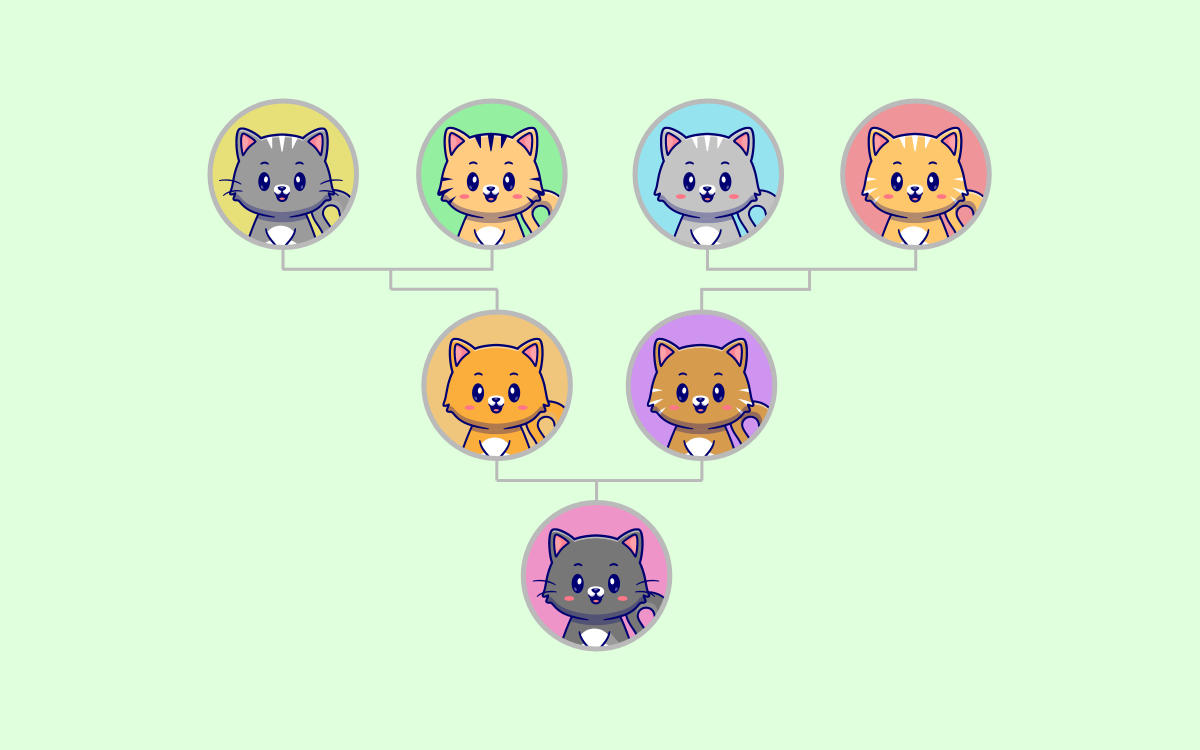It’s rare that a pet blog would talk about plants, but we can make an exception for genealogical trees since they are metaphorical plants, not literal ones.
What is a genealogical tree?
A genealogical tree is a diagram of family history, using standardized symbols. The different family members and the relationship that binds them are reflected in the diagram.
This includes deceased relatives.
While genealogical trees have multiple uses, the most common is to track pathologies within a family and the type of heritability it exhibits.
Anyone who has studied a bit of biology will remember those circles and squares connected by lines, staring at them to understand the type of inheritance the traits represent.
Genealogical trees are not unique to humans.
Pets have families, which is actually the only requirement to have your own genealogical tree. In our blog post “Understanding the DNA of Breeds: Pedigree” we’ve briefly mentioned this.
Perhaps some users might think: “Of course they have a genealogical tree, it’s in mine.“
Yes, but no. Genealogical trees, despite their curiosity factor and trendiness, have a historical and scientific foundation. They serve to understand the history of a family and its past. Pets are part of the family story, not its genealogy.
They have their own genealogy.
Besides the stress future historians will experience when municipal records say you’ve had three children, but your genealogical tree includes a fourth named “Don Patitas Peludas.”
That doesn’t negate their strong bond with the families they’ve lived with. For example, the Weimaraner breed of dog gets its name from its “family.” Grand Duke Charles Augustus of Saxe-Weimar-Eisenach and the nobles of the Weimar region selectively bred these dogs for years to create a perfect breed for hunting in their forests.
Pets are part of families, but not part of genealogical trees.
What is the purpose of a dog’s or cat’s genealogical tree?
Just like with people, you have two main ways of discovering your pet’s lineage:
– Historical records: This is easier if your dog comes from a purebred breeder, is a show animal, or its family has been living alongside yours for generations.
– Genetic analysis: The same DNA tests used to obtain a pet’s pedigree and/or find relatives worldwide will help you uncover their family history and genealogical tree.
And just like with people, knowing your pet’s genealogical tree has multiple uses.
In the beginning, the primary interest was to know and maintain the purity of a family line. Similar to royal houses, animals were bred in a controlled manner, and records of the resulting families were kept.
This also had a second function: health. Breeders used these genealogical trees and the information they contained to try and produce the healthiest animals possible, while strengthening those traits of interest.
As mentioned earlier, genealogical trees were very important in medicine (and veterinary medicine) to try and prevent and avoid hereditary pathologies in animals.
If a family suffered from a disease, it was important to avoid breeding with it, even if the individuals didn’t show symptoms.
Breeders also avoided strong inbreeding, as they were well aware of the long-term consequences of putting brothers and sisters together.
Another use, and perhaps the most innocent of all, is curiosity.
Let’s be honest, wouldn’t you like to discover that your cat had a great-grandmother catching mice in a national library?
Or find out that your dog, peacefully sleeping in the sun, carries the blood of powerful hunters who accompanied European kings?
Knowing this information won’t change your relationship with your pet or help you take better care of their health. But you’ll enjoy knowing it.
And you’ll be able to show it off for a long, long time.
A genealogical tree also allows you to know not only your pet’s breeds, but also the breeds of their ancestors and family.
The Koko pet DNA test reveals both your dog or cat’s breeds and those of their ancestors, up to three generations back. This way, you’ll know the breeds your friend has and where they inherited them from.
We guarantee that we have enough dog breeds and cat breeds for you to see a genealogical tree more beautiful than you imagined.
Genealogical trees in the present day
In addition to dogs and cats, many other species benefit from genealogical trees and the information they provide.
Horses were among the first beneficiaries of this tool, and they continue to be to this day. They were the first animals to have pedigrees.
Genealogical records are essential to maintaining breed purity and improving both the performance and physical characteristics of animals.
Beyond recreational activities, zoos and wildlife reserves don’t turn down a good genealogical tree when they see one.
By keeping records of lineages, inbreeding is avoided, the propagation of hereditary genetic pathologies is reduced, and a broad and adequate genetic diversity is maintained.
The species that benefit most are those at risk of extinction, where repopulation efforts are being made, such as rhinoceroses or the Iberian lynx.
There is a term called “functional extinction”, which involves specific situations related to the extinction of a species. One of these occurs when a population is no longer viable because the few remaining breeding individuals are genetically similar and have very low genetic diversity.
Genealogical trees and their tracking help prevent these situations.
Learning about your pet’s history has only advantages, like those offered by the Koko genetic analysis.
